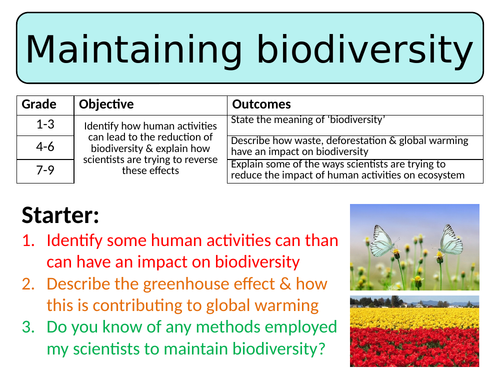
This lesson is designed for the NEW AQA Trilogy Biology GCSE, particularly the ‘Ecology’ SoW.
For more lessons designed to meet specification points for the NEW AQA Trilogy specifications for Biology, Chemistry and Physics please see my shop: https://www.tes.com/teaching-resources/shop/SWiftScience
The lesson begins with a definition on biodiversity, pupils are shown a pie chart of the numbers of different groups of organisms that have been identified to date. The first task is for pupils to consider which numbers correspond to which groups of organisms. Once pupils have discussed in pairs or groups the answers will be revealed, pupils can check their work against the answers provided.
The next part of the lesson focuses on how and why scientists quantify biodiversity, pupils are firstly asked why it might be important to map out biodiversity - they can discuss in groups before the answer is revealed on the PowerPoint presentation.
A map of the world depicting certain biodiversity hotspots is then shown to students and they are asked a couple of question about this map, pupils will be required to answer these questions in their books and then self-assess their work using the answers provided.
Pupils are then asked to think > pair > share their ideas on why it is important to maintain biodiversity, in groups pupils may be given an A3 sheet for them to mind map their ideas onto. Once finished each group can feedback their ideas to the class and a larger mind map could be completed on the white board. Some of the key reasons for maintaining biodiversity cant then be detailed on the PowerPoint presentation for students to assess their work.
The last task is for pupils to use information posters placed around the room to answer a set of questions, all on the topic of maintaining biodiversity. Once pupils have spent a good amount of time writing their answers down they should sit in their seats and use the mark scheme provided on the PowerPoint presentation to peer-assess their work.
The plenary activity is for pupils to draw a feedback grid in their partners books and write down one positive comment, one negative comment and a question to test their knowledge.
All resources are included at the end of the presentation. Thanks for looking, if you have any questions please let me know in the comments section and any feedback would be appreciated :)
Get this resource as part of a bundle and save up to 56%
A bundle is a package of resources grouped together to teach a particular topic, or a series of lessons, in one place.
Something went wrong, please try again later.
Thank you for saving me time. I just needed to adjust them for all class assessment.
Report this resourceto let us know if it violates our terms and conditions.
Our customer service team will review your report and will be in touch.
